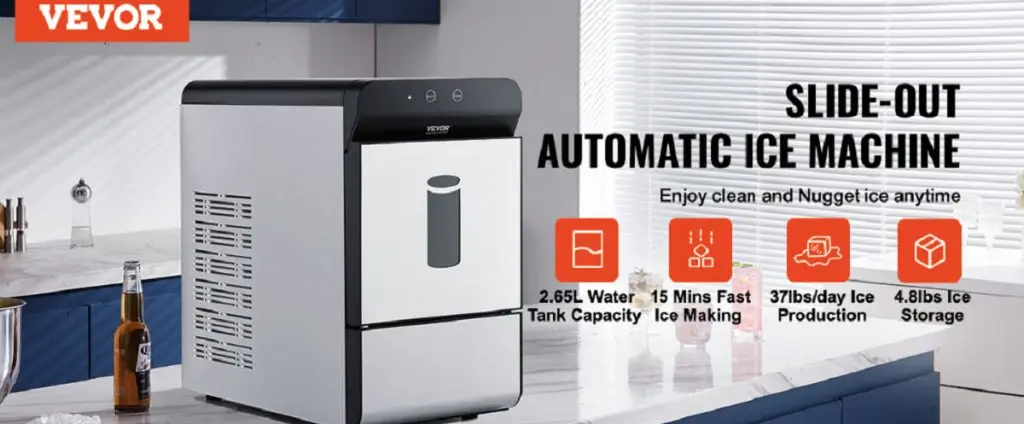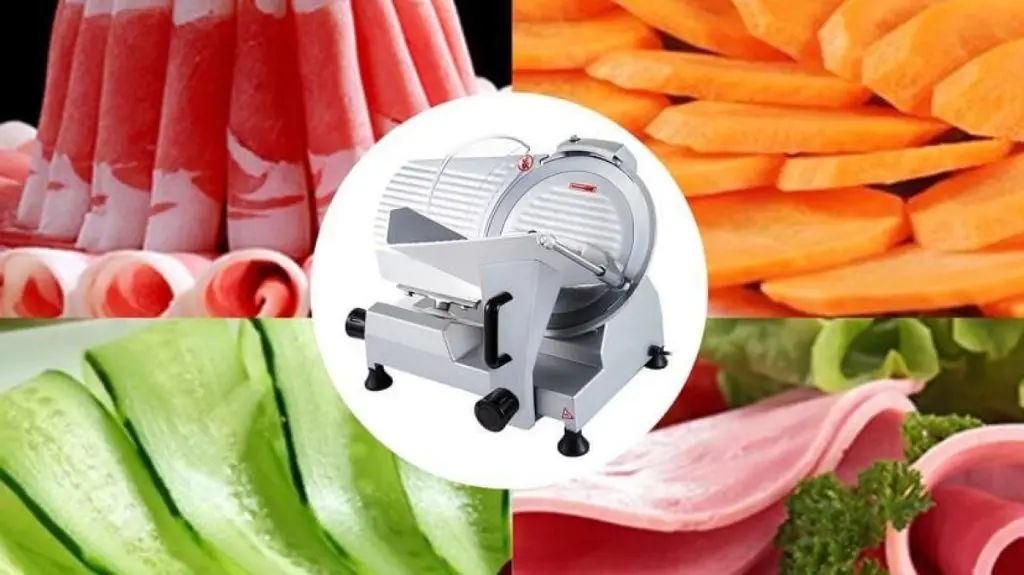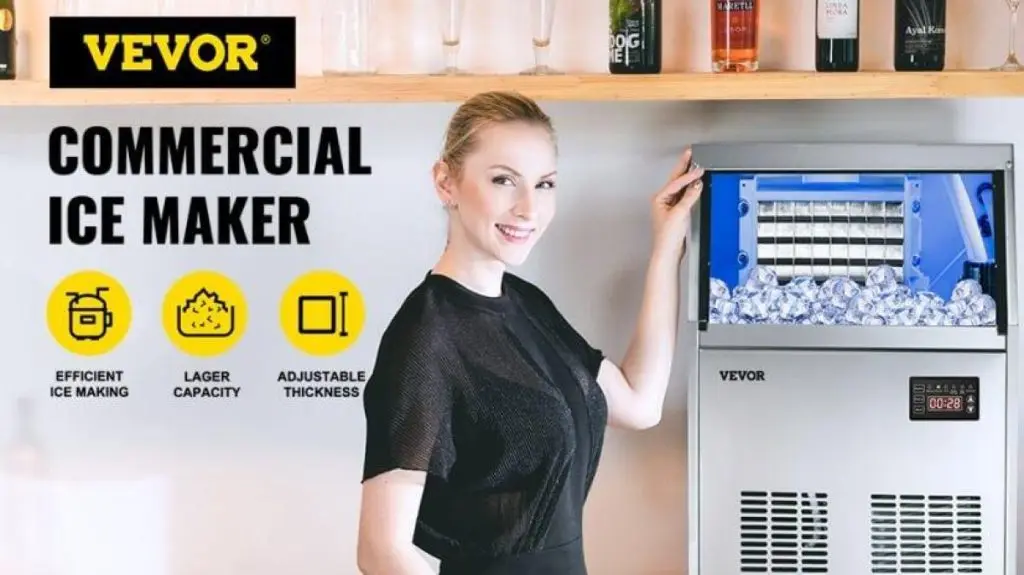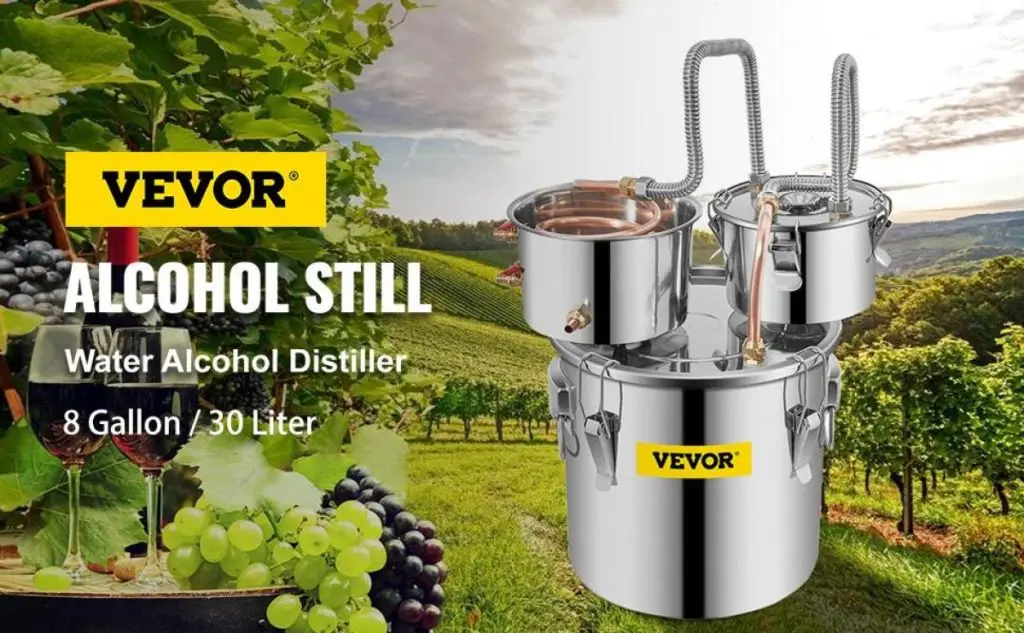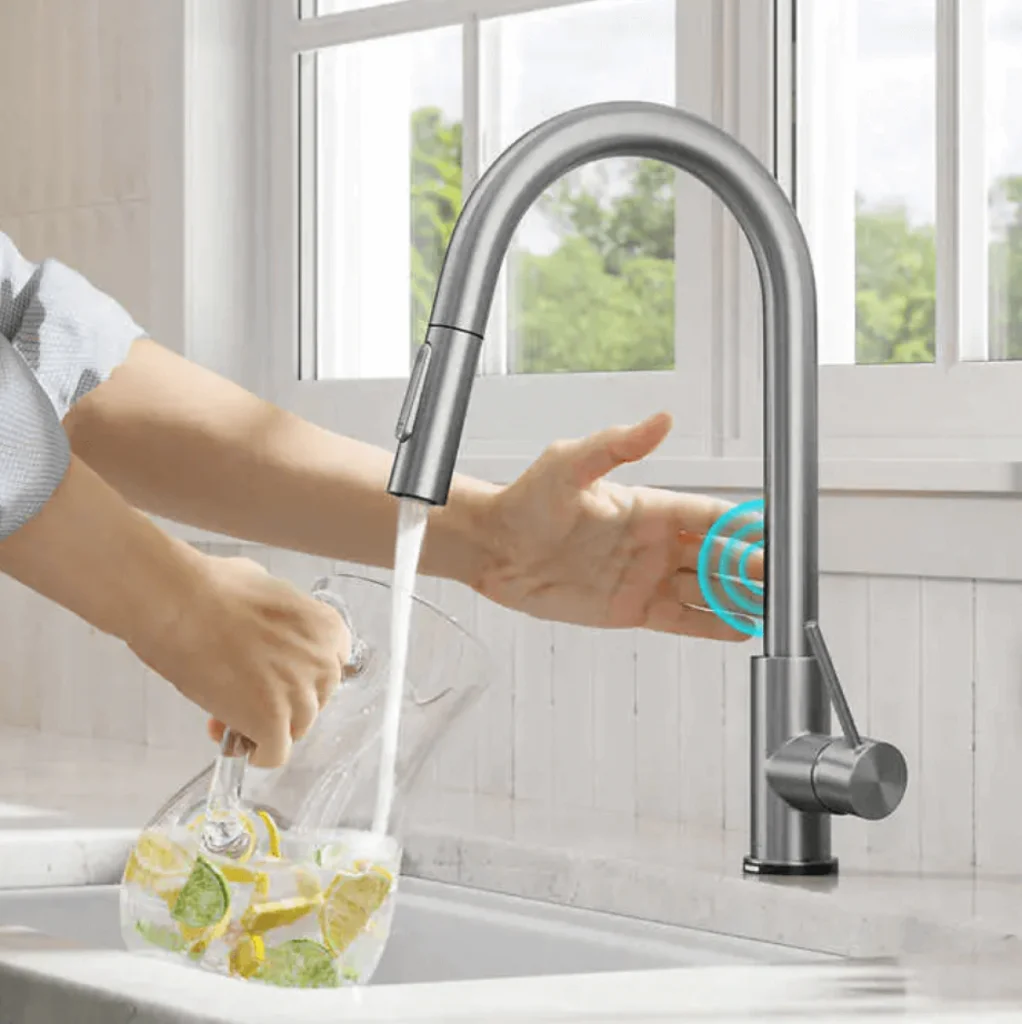Nothing is quite as refreshing as a cool drink on a hot summer’s day. Whether you’re hosting a barbecue cookout or having friends over for dinner, a well-made drink filled with ice and chilled to perfection is exactly what you need to keep your guests happy.
Thanks to countertop ice makers, you can have all the ice you need on demand. With an ice maker, you don’t need to make last-minute trips to the store because you can have an unlimited supply of ice at your fingertips.
When it comes to the many countertop ice makers available, VEVOR stands out. The VEVOR portable ice maker is fast and effective enough to produce ice cubes in as little as 15 minutes.
But how do countertop ice makers work?
Let’s find out!
Table of contents
What is a Countertop Ice Maker?
Before we answer the question, how do countertop ice makers work, we need to first understand what exactly a countertop ice maker is.
Definition and Purpose
Portable ice makers are compact devices that produce a steady supply of ice faster and more efficiently than traditional ice machines. They work similar to ice makers that are built into refrigerators.
However, while traditional ice makers are permanently attached to refrigerators, a portable ice maker can easily sit on your kitchen countertop or be carried around when necessary. This makes it a convenient choice for use in homes, offices, and outdoor activities.
Benefits of Using a Countertop Ice Maker
Now, you may be asking, why use a countertop ice maker? Well, a countertop ice maker is a popular choice for several reasons, some of which include:
- Convenience & Accessibility: One of the most obvious features of a countertop ice maker is its portability. It is designed to provide easily accessible ice cubes whenever you need them. Additionally, because it doesn’t have to be in a stationary place, you can conveniently carry it anywhere you want. Traditional ice makers do not provide this flexibility.
Countertop ice makers are also much faster than other options. So, even if you have a refrigerator ice maker, the experience will not be the same. With the refrigerator ice maker, you’d have to wait hours for the ice tray to fill up and form cubes. However, a countertop ice maker can provide ice cubes within minutes. Talk about convenience!
- Cost-Effectiveness: Countertop ice makers are a cost-effective choice compared to other options. Without them, you would typically have to go to the store to buy ice, which incurs transportation and purchase costs. However, these costs are all eliminated with a countertop ice maker.
To add to that, countertop ice makers are designed to produce limitless numbers of ice cubes. You can literally have as many as you want without having to pay extra. So, all you need to do is make the initial purchase of the countertop ice maker and you can enjoy free ice cubes for life!
How Does a Countertop Ice Maker Work?
Now, to the most interesting part: how does a countertop ice maker work? Well, it’s a pretty fascinating machine. Let’s break it down for you.
Overview of the Working Process
A countertop ice maker consists of a water reservoir, condenser, evaporator, ice-making tray, inlet valve, and thermostat. The water in a countertop ice maker goes through a pumping and cooling system and an ice-making cycle before it can form ice cubes.
Unlike traditional ice markers, a countertop ice maker does not need to be connected to a water line. Therefore, it has a water reservoir that must be filled up in order to create ice cubes.
The water then flows from the reservoir, which ensures a steady supply of water to the cooling system. In the cooling system, the temperature of the water is gradually lowered. Finally, it reaches the ice-making cycle, where ice cubes are created at the end of the process.
Shortly, we’ll discuss the step-by-step process by which ice cubes are created, but before that, let’s compare countertop ice makers to traditional ice makers.
Differences Between the Countertop and Traditional Ice Makers
Countertop ice makers and traditional ice makers both share the core function of creating ice. However, they differ in many ways.
- Countertop ice makers are generally small and portable, while traditional ice makers are larger and stationary, making them harder to move around.
- Countertop ice makers usually come with a water storage unit or reservoir, which contributes to their portability. On the other hand, traditional ice makers need to be connected to a water line before they can produce ice.
- Countertop ice makers have shorter ice production cycles than traditional ice makers.
- Countertop ice makers consume less energy than traditional ice makers.
Advantages of Countertop Ice Makers
Countertop ice makers are a preferred choice because they:
- Are more cost-effective
- Produce ice faster than traditional ice makers
- Are easy to operate and do not require complex set-up processes like traditional ice makers.
- Are more compact and are ideal for users with limited space
Recommended For Your Project
Components of a Countertop Ice Maker
To really get the picture that answers the question of how do countertop ice makers work, you must also understand the various components of this powerful machine. Let’s break them down below.
- Water Reservoir: This component stores the water that will be converted to ice. The size of the water reservoir varies, depending on the quantity of ice cubes the countertop ice maker can produce. An average water reservoir can hold about 2.65 L of water.
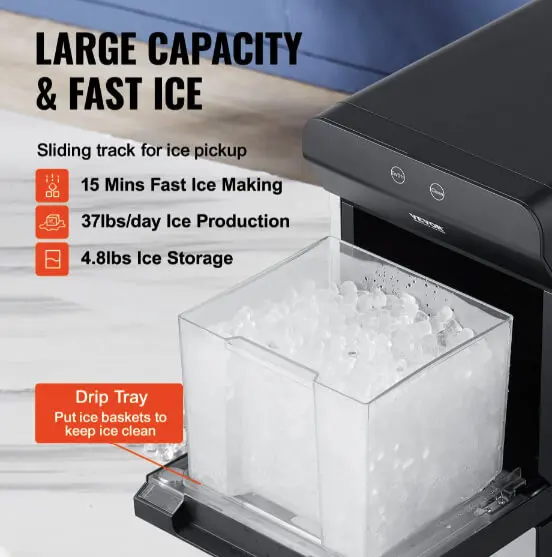
- Cooling Mechanism (Compressor vs Thermoelectric): This is one of the most important components of a countertop ice maker because it is responsible for pressurizing refrigerant gas, which freezes the water you put it in. The cooling mechanism could either be a compressor or thermoelectric.
- Ice Tray and Freezing Elements: Like a traditional ice maker, a countertop ice maker also has an ice tray and other freezing elements, such as the ice mold. This is where ice cubes are produced when a high-pressure liquid expands and produces a cooling effect. The ice tray and mold can produce ice cubes of different shapes, such as full cube, crescent, nugget, bullet, and gourmet.
- Sensors and Controls: This includes the thermostat, which constantly monitors the temperature of the water inside the countertop ice maker. It is equipped with a sensor that signals the compressor to resume or pause the cooling process when it reaches certain temperatures. This component also comprises a control unit, which regulates the inlet valve and controls the amount of water that flows into the reservoir at every given time.
- Ice Storage Bin: Finally, we have an ice storage bin. It goes without saying that this is the compartment where freshly malice cubes are stored till they are ready for use. It can sometimes be equipped with an insulated material that helps to keep the ice cubes cold for a while before you are ready to use them.
Step-By-Step Process of Making Ice in a Countertop Ice Maker
Now that you have a basic knowledge of the question: how do countertop ice makers work? Let’s walk you through the process of using one.
- Filling the Water Reservoir: The first thing to do is to fill the water reservoir with enough water to produce several cycles of ice cubes. If you don’t fill the reservoir up, you will not get as much ice cubes as you typically should. Always ensure the water you use is clean and drinkable.
- Pumping Water into the Freezing Tray: Next, pump water into the freezing tray. Ensure the tray is clean and free from debris or foreign objects that might interfere with the freezing process.
- Cooling and Freezing Process: Allow the water to cool and eventually form ice cubes. In this step, the liquid refrigerant expands and enters the evaporator coils. As the evaporator coil cools, so does the water. When the temperature cools long enough to drop below freezing point, ice cubes are formed.
- Harvesting the Ice: Now, your ice cubes are ready! When the ice cubes are formed, the thermostat usually signals the compressor to stop any more water from entering through the inlet valve. The ice tray then ejects the ice cubes into the ice bin, where you can collect them.
- Storing the Ice: Once the ice cubes are formed, you can collect them and use them right away. If you don’t, they will begin to melt back into water, which will be collected in the water reservoir. However, if you’re not ready to use the ice cubes right away, you can collect them and store them in a refrigerator to keep them cold.
Features to Look Out for in a Countertop Ice Maker
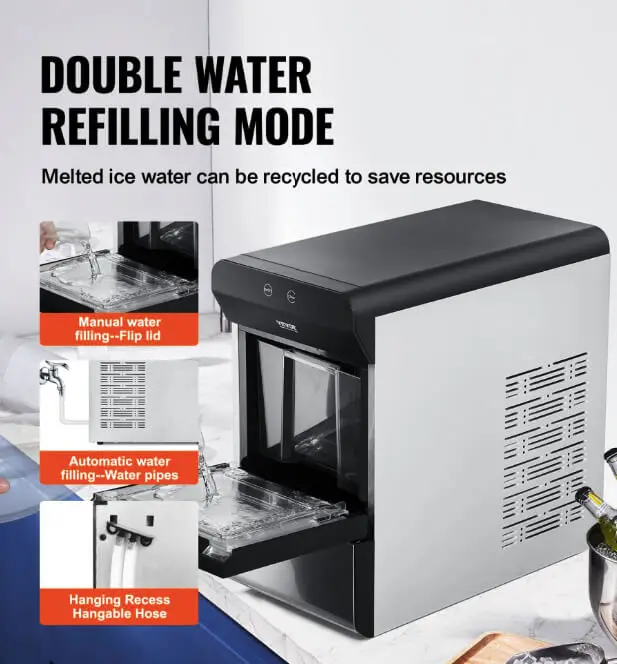
Now that you understand how a countertop ice maker works, let’s examine the features to consider when choosing one.
- Ice Production Rate: Look out for the duration of the ice production cycle. A good countertop ice maker should be able to produce ice cubes in about 10 to 20 minutes.
- Ice Size and Shape Options: Look for ice makers that allow you to adjust the size and shape of the ice tray and molds. These will determine the size and shape of the ice cubes they produce.
- Ease of Use and Maintenance: Look out for countertop ice makers that are easy to clean, use, and maintain. Choose one that has compartments which can be easily dismantled for deep cleaning. It should also have simple controls that beginners can easily navigate.
- Portability and Design: A countertop ice maker that isn’t portable basically defeats its purpose. Therefore, look for one that is designed to be easily carried around. It should be lightweight and should have a design that matches your aesthetic.
- Additional Features: Good countertop ice makers should be equipped with additional features, such as timers and self-cleaning functions. Timers will signify when an ice production cycle has been successfully completed, while self-cleaning functions will save you a lot of clean-up time after you have finished using the machine.
Why Choose VEVOR Portable Ice Maker?
It’s not just enough to get the answer to the question: how do countertop ice makers work? Our guess is that you’re also looking for the best countertop ice maker that’s worth investing in.
Look no further! We have an answer to that, too!
The VEVOR portable ice maker is one of the most highly recommended choices for a couple of reasons. Here’s why:
- Efficiency and Speed: When it comes to efficiency and speed, VEVOR tops the list. It’s capable enough to produce about a total capacity of about 37 lbs of ice in 25 hours. It has a capacity of 4.8 lbs and can complete an ice production cycle in as little as 15 minutes.
- Portability and Convenience: The VEVOR portable ice maker has a sleek and portable design that makes it easy to transport to your office, barbecue, and other locations.
- Cost-Effectiveness: VEVOR offers competitive pricing compared to other countertop ice maker brands.
- Environmental Impact: VEVOR is not only efficient, it is also very environmentally friendly as it consumes little energy, with low noise levels. It also doesn’t produce harmful fumes and emissions that are detrimental to the environment. If you’re someone who cares about our planet, try VEVOR.
- User-Friendly Design and Features: The VEVOR portable ice maker is designed with user-friendly features that make it easy to operate. It is self-cleaning and has an automatic water-filling feature that automatically fills the reservoir with water when needed, so you don’t have to. It is also equipped with an intelligent UV mode that automatically starts when you turn the machine on, so you don’t need to boot it manually. How convenient is that?
FAQs
How does a countertop ice maker work?
A countertop ice maker comprises different components, such as the water reservoir, compressor, ice tray, sensors, thermostats, and controls. Once you fill the water reservoir, it goes through a pumping system and flows to the ice tray. The compressor then pressurizes the refrigerant gas, which begins to expand and lower the temperature of the water until it falls below freezing point, causing ice cubes to form.
How does an ice maker work in general?
Ice makers work using a vapor-compression refrigeration cycle based on the principle of thermodynamics. During this process, the compressor converts the cooling refrigerant from liquid to gas, which then absorbs the heat surrounding the liquid, thereby lowering the temperature till it reaches freezing point. When this cooling cycle is complete, ice cubes are formed.
How long does it take to make ice?
The duration of an ice-production cycle generally differs based on the type and quality of the ice maker you use. A good countertop ice maker can produce ice cubes in as little as 10 to 20 minutes. However, traditional ice makers and refrigerators will take longer.
Can a countertop ice maker be used outdoors?
One of the advantages of using a countertop ice maker is that it is portable enough to be carried everywhere, including outdoors. As long as it has access to power, it can be operated outdoors.
Conclusion
If you’ve been searching for an answer to the common question: how does a countertop ice maker work? This article will give you all the answers you need.
Countertop ice makers work by using a compressor to pressurize refrigerant gas, which then lowers the temperature of the water until it forms ice cubes.
When choosing a countertop ice maker, look out for essential features, such as ice production rate, ice size and shape, portability, ease of use, and ease of maintenance.
Good news! You don’t have to look further, because the VEVOR portable ice maker checks all these boxes and more! It stands out because of its 4-layer thermal insulation, which allows you to keep your ice cubes cold for up to eight hours after a power outage.
It’s designed with a hands-free automatic cleaning mode and a drip tray that helps to keep your ice cubes clean. It is also equipped with a 2.65 L tank that can produce up to 37 lbs of clean, nugget ice anytime, any day!
Check out the VEVOR portable ice maker now!

